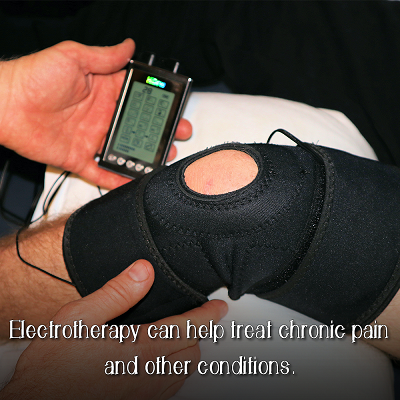 Electrotherapy uses electric current to help alleviate the pain felt throughout the body by promoting the healing of the muscles and the regeneration of new muscle tissues. Electric current is sent through the body with the use of electrode pads, which are placed on the different parts of the body experiencing pain.
Electrotherapy uses electric current to help alleviate the pain felt throughout the body by promoting the healing of the muscles and the regeneration of new muscle tissues. Electric current is sent through the body with the use of electrode pads, which are placed on the different parts of the body experiencing pain.
The mild electric current sends signals to the nervous system and blocks the body’s pain signals, thus lessening the pain felt by the body. The electric current also promotes the production of endorphins, which is the body’s natural pain reliever.
Electrotherapy may sound like it’s a new type of energy healing therapy, however, it has actually been used since the 18th century!
Many patients who use electrotherapy also use it in conjunction with other treatments they may need, such as physical therapy. By using electrotherapy they feel less pain when they have to perform some of the different exercises in their physical therapy sessions.
Different Types of Electrotherapy
There are different kinds of electrotherapy, however, they all make use of electric currents in managing pain. You may have heard of the TENS machine for treating pain, but there are quite a few others. Here are the different types of electrotherapy used today.
- Transcutaneous electrical nerve stimulation (TENS)
- Percutaneous electrical nerve stimulation (PENS)
- Electrical muscle stimulation (EMS)
- Interferential (IFC)
- Pulsed electromagnetic field therapy (PEMF)
- Galvanic stimulation (GS)
TENS is a popular form of electrotherapy and possibly the most widely used electrotherapy treatment. It helps with chronic pain and nerve pain.
PENS is a more intensive electrotherapy treatment and uses needles instead of electrode pads to further penetrate the muscles. PENS is usually only used if TENS treatments prove to be unsuccessful.
EMS targets weakened muscles and the muscle tissues directly, while PEMF is more to improve cellular functions. IFC is another treatment to help reduce pain and stimulate the muscles and blood flow. It is often used to treat circulatory problems.
The type of electrotherapy treatment a patient will receive will depend on the type and severity of their condition, and will also be determined by their respective health provider.
Benefits of Electrotherapy
Though there are different kinds of electrotherapy, all of these provide an alternative solution to the use of traditional medicines in treating pain and improving health in many areas. Electrotherapy can provide pain relief to specific parts of the body, improve the healing of wounds and prevent muscle loss.
If treatment is given at a low frequency it can help release endorphins that act as natural painkillers.
Electrotherapy has been proven to be effective in treating muscle spasms, preventing muscular degeneration, improving blood circulation, strengthening muscles, improving range of motion, alleviating muscle pain, reducing nerve pain, and facilitating faster wound recovery.
Patients who are suffering from many chronic pain conditions, such as back pain, sciatica, fibromyalgia, arthritis, and other painful health complications may make use of electrotherapy as a supportive treatment to physical therapy.
Are There Side Effects to Using Electrotherapy?
Using electric currents may sound intimidating but in reality, electrotherapy itself does not cause adverse side effects. Many patients report feeling relaxed throughout their session. The buzzing and tingling sensations caused by the mild currents are safe and do not cause patients to feel any discomfort.
However, rashes, redness, and irritation on the skin caused by the overuse of adhesives on the electrode pads have been shown.
It is important to note that electrotherapy is not recommended for some people, including those people with heart problems, those who are using an electrical or mechanical cardiac implant, or pregnant women.
If you are considering using electrotherapy, it certainly has helped many people manage their pain. It is a safe alternative therapy that is effective, non-invasive, and non-addictive. It can also be used alongside many other types of treatments or prescription medications. Electrotherapy is a therapy that has improved the lives of thousands of patients all over the world.






